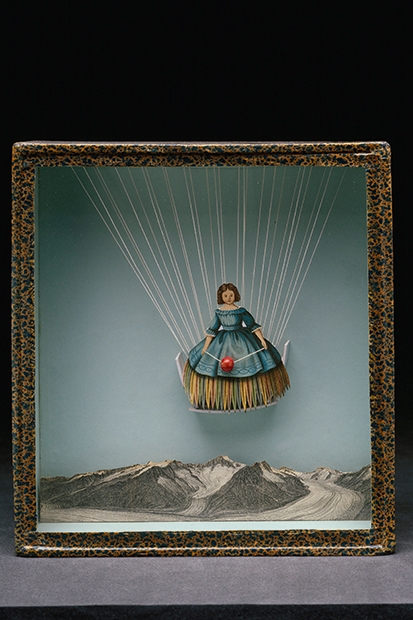Someone once asked Joseph Cornell who was his favourite abstract artist of his time. It was a perfectly reasonable question to put to a man who numbered Piet Mondrian, as well as other masters of modernism, among his acquaintance. But, characteristically, Cornell veered off at a tangent. ‘What’, he replied, ‘do you mean “my time”?’ In its way it’s a good response, as the exhibition at the Royal Academy, Joseph Cornell: Wanderlust, makes clear.
The subtitle of the show refers to travel in mental space. In mundane reality, Cornell (1903– 72) seldom left New York City, and never ventured further afield than Maine. But in his imagination, he journeyed across the world and dwelt, mentally, in an era earlier than his own.
Art historically, the name Cornell immediately evokes the word ‘box’: his trademark medium was a small wooden case with a glass front. It is largely these that fill the Sackler Galleries at the RA, making this a paradoxical experience: a large exhibition in a fairly small space. Cornell’s boxes themselves are of a convenient size to keep on a desk or dressing-table. But each one may contain a miniature world of images and associations, bric-à-brac and this and that.
A fairly typical example — except that nothing about Cornell quite ran to type — is ‘L’Egypte de Mlle Cléo de Mérode’ (1940). This consists of an oak casket, lined with marbled paper, with the title and subtitle — cours élémentaire d’histoire naturelle — on the interior of the lid. Within are a collection of little glass bottles, topped with cork, and containing mineral specimens and other items. One, carefully labelled ‘reptiles of the Nile’ in minute letters, preserves little spirals of paper presumably representing snakes; another has a tiny photograph, of Cléo de Mérode herself, a dancer and celebrated beauty of the 1890s.
So this is a boxful of complicated references. It suggests at once a collection of scientific specimens, a travelling set of perfumes and cosmetics, and mementoes of a country — Egypt — that Cornell never visited. If you find all this whimsical — pretentious even — then you won’t like Cornell, and this exhibition isn’t for you. On the other hand, if it strikes you as delicately poetic, then you may find Cornell and his work addictive.
He was a strange case. His biography — a life spent in a quiet suburb, living with his mother and invalid brother, amid an accumulation of junk-shop curiosities that were the raw materials for his work — suggests what the art world terms an outsider. But Cornell was far from being a lone eccentric. On the contrary, he was rapidly accepted, exhibiting at the Museum of Modern Art and admired by, among others, Marcel Duchamp.
Cornell, indeed, was one of the few ever to ruffle Duchamp’s philosophical cool. At their first meeting, or so the story goes, they discussed the topography of central Paris in enormous detail, building by building — and in French — Cornell mentioning casually only afterwards that he had never visited the city. Duchamp was lost for words.
Cornell’s art was touched off by surrealism — of which he saw an exhibition in his late twenties, when he was working as a textile salesman. But he insisted he was not a surrealist, because he was not fascinated — as proper surrealists were — by the psycho-sexual jungle of the subconscious.
His work was more an exercise in false memory, an evocation of times and places he hadn’t experienced, such as 16th-century Italy in ‘Untitled (Medici Princess)’ (c. 1948) in which a Bronzino portrait is set amid birds, beasts and symbols as if in a chamber of curiosities.
At the time, people found Cornell’s work hard to classify. One dealer sold his boxes as ‘toys for adults’ (and indeed many of them need to be handled, the drawers opened, the containers rattled, a problem that the exhibition tries to solve with little films and recordings).
In retrospect, they fit more easily into art history. Cornell’s ‘Pharmacy’ (1943) is a precursor of Damien Hirst’s gleaming display cases. These are also filled with shells, butterfly wings and mysterious powders but Cornell’s is on a miniature scale — and much more charming.
It is the charm of a ship in a bottle. Except it wasn’t ships Cornell searched out in the shops and museums of Manhattan, but fragments evocative of a European past he never actually knew. He preserved these like holy relics in his boxes.






Comments